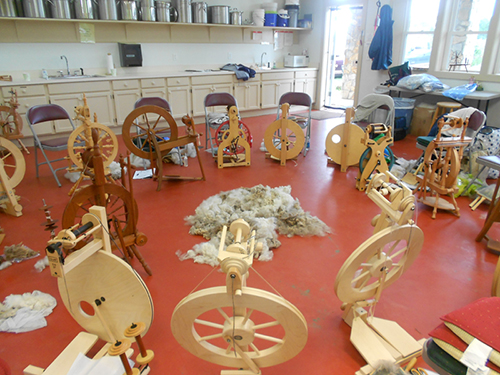I started volunteering with the Gibbes almost five years ago after getting a master’s degree in art history. Since then I’ve worked on numerous projects in the curatorial department, helped with art camp one summer, and become a museum educator. While not at the museum, I work at a local stained glass studio, Blue Heron Glass, where I teach and create unique works of glass art.

I was able to combine my interests in art and education, including my obsessions with knitting and yarn, on my recent vacation to the John C. Campbell Folk School in North Carolina. I took a week-long spinning class (spinning yarn, not bicycles) with a good friend and we stayed at one of the school’s houses. Neither of us had ever spun yarn before, but we were both excited for the challenge. The school is located in the mountains in a small town called Brasstown, NC, very near the Georgia and Tennessee borders. They offer classes all year long and in many different topics like fiber arts (spinning, knitting, weaving, quilting, etc.), blacksmithing, pottery, writing, painting, woodturning, music, and other folk arts.
It was like stepping into a different time and onto a slightly different planet. Upon checking in, we learned that there were no keys to the rooms and while our linens were provided, we had to make our own beds. Meals were included with our board and all the dining was family-style where we served ourselves and bussed our own tables. It was camp for adults (although they welcome young ones to the school). Much of the food was grown in the school’s gardens and they baked most of the bread there. There were numerous paths and trails on the grounds, and we enjoyed walking through the woods and fields of the school.

Our spinning instructor was from Boulder, CO and there were people from all across the country in our class. We started by discussing how to prepare a fleece directly from the sheep and moved on from there. Over the course of the week we spun yarn from five different breeds of sheep, cotton, silk and commercially available roving. We learned about different types of spinning wheels and even played a little with drop spindles. We played with hand carders, drum carders, long combs and all sorts of other tools that looked like torture devices. The most exciting and crazy thing we tried was spinning cotton thread directly from unprocessed cotton bolls. One afternoon we took an impromptu field trip to a local sheep farm.
Along with the classes they had activities in the evenings like demonstrations from other classes, a contra dance, and a concert on Friday night. Every morning there was “Morning Song,” a 30 minute session of blue grass music and storytelling. There was a fabulous craft shop just under the dining hall that featured goods made by various teachers at the folk school and a book room. Meal times were also a treat because we met interesting people from other classes. Some students were learning totally new skills, like us, while others were taking intermediate or advanced courses.
Overall, it was an amazing experience and I can’t wait to go back. It was such a pleasure to see so many dying arts and crafts alive and well at the folk school and I realized that there are so many other things I want to learn. I just need to figure out what to make with all my hand-spun yarn!

—Rebecca Heister, Museum Educator and Volunteer
Published July 25, 2014

